NASA robots may climb the walls of the International Space Station one day using grippers inspired by the super-adhesive feet of geckos. Scientists at the space agency's Jet Propulsion Laboratory (JPL) in Pasadena, California, are
developing a "gecko gripper" system that could help robots inspect and repair the space station's exterior, and perhaps conduct a wide range of activities in Earth orbit.
The gripping system doesn't lose its stickiness over time the way tape does, researchers added, and it should work well in all environments - even those featuring extreme temperatures, pressures and/or radiation conditions. The lizards rely on millions of tiny hairlike protrusions that become powerfully adhesive (to the electrons orbiting atoms) when bent, due to a phenomenon called van der Waals forces.
The team has already started testing out the gecko gripper in the micro-gravity environment, using the technology to grab and manipulate objects during parabolic airplane flights. The researchers have also affixed gecko-gripper feet to a climbing robot called Lemur 3, which can clamber over simulated solar panels and other spacecraft parts as a result.
Related article:
Climb der Waals with gecko-inspired grippers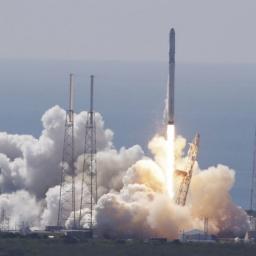
SpaceX's perfect launch record came to an end, today, as an unmanned cargo ship destined for the International Space Station
exploded minutes after launching from the Cape Canaveral Air Force Station in Florida on Sunday morning. The 208-foot-tall (63-meter) rocket was the company's 19th Falcon 9 launch since its 2010 debut, including six previous cargo runs for NASA under a 15-flight contract worth more than $2 billion.
The spacecraft carried 2,477kg of food, clothing, equipment and science experiments for the station. The gear included the first of two docking systems for space taxis under development by SpaceX and Boeing to park at the station. NASA hopes to turn over crew transportation to the US companies before the end of 2017, breaking Russia's monopoly. The crew on the International Space Station has about four months of food and supplies on board, so the accident does not pose an immediate problem for them. However, NASA's second cargo transporter, run by Orbital ATK , remains grounded following
a launch accident in October. In April, a Russian Progress cargo ship
also failed to reach the station.
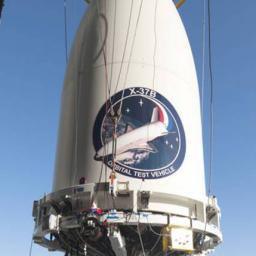
The US Air Force has responded to fears that it is weaponizing space through its secret space shuttle by providing some details of what it will contain at launch on Wednesday. The now not-so-secret X-37B launched from Cape Canaveral in Florida on an Atlas V rocket operated by the United Launch Alliance.
According to the published manifest the X-37B will be carrying a new form of Hall ion-powered thruster, ten CubeSats, a satellite containing a TCP/IP web server, test equipment for plasma thrusters, and a device to control low-orbital vehicles, among other gizmos.
The ion thruster being carried aboard the X-37B is owned by the Air Force Research Laboratory (AFRL) and is a new, hopefully more efficient version of a drive system that uses electrical fields to accelerate ions for thrust. An older model is currently in use on three military communications satellites. "Space is so vitally important to everything we do," said Major General Tom Masiello, AFRL commander. "A more efficient on-orbit thruster capability is huge. Less fuel burn lowers the cost to get up there, plus it enhances spacecraft operational flexibility, survivability and longevity." There's no word on how long testing will take, but it's not really an issue for the X-37B - the spacecraft already holds the longevity record for a reusable spacecraft with a 674-day sojourn that ended last year. That's a lot of testing time and it's likely there's more in the X-37B's holds than the Air Force is letting on
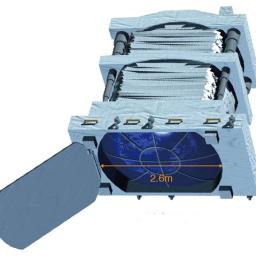
According to NASA, there is almost 3,000 tons of space debris residing in a low-Earth orbit. This includes old, derelict satellites, leftover rocket parts and bodies, and other parts and tiny bits of wreckage produced by collisions of other larger objects. Impacts from this junk can cause damage to satellites due to their speed, as most are traveling about 22,370 miles per hour. As more and more satellites and spacecraft are sent into space, the problem of space debris is growing. Most spacecraft, including the International Space Station, can withstand impacts from most of the smaller junk in the neighborhood of 0.4 inches due to the shielding on the crafts. However, there are more than 700,000 pieces larger than that currently in orbit. While items larger than 4 inches are easy to spot, the ones between 0.4 inches and 4 inches in size are difficult to identify and dodge.
Researchers at the Extreme Universe Space Observatory
could be getting a powerful laser installed in the Japan section of the International Space Station to help shoot down the space junk. Once the EUSO detects space junk, the Coherent Amplification Network laser would then blast the debris, burning off a thin film of matter from the surface and nudging the junk downward to burn up in Earth's atmosphere. The full-scale version would be armed with a 100,000-watt ultraviolet CAN laser than could fire 10,000 pulses per second. Researchers believe that this could blast space junk from a range of about 60 miles.
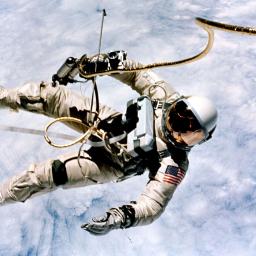
Fifty years ago on Wednesday, NASA astronaut Ed White stepped out of his space capsule and
walked in space for the first time. White's spacewalk was part of NASA's Gemini program. He left the confines of his Gemini capsule while astronaut James McDivitt stayed inside, monitoring the walk. Since White's historic spacewalk (called an extra-vehicular activity, or EVA, in NASA-speak), the space agency has continued to send men and women into the vacuum of space with only a well-designed suit to protect them. In total, NASA astronauts have performed more than 260 spacewalks, including the EVAs that put people on the moon for the first time.
"Without the path first blazed by Ed White - and before him, Russian cosmonaut Alexei Leonov - our current platform in space would not be possible," Pearlman said. Spacesuits and spacewalking methods have also evolved since White's spacewalk in 1965. "When astronauts someday walk on the surface of Mars, they will do so in part because of the journey begun by Gemini 4 and the 20-minute spacewalk performed by Ed White 50 years ago," he said. White died tragically in
the Apollo 1 fire in 1967, along with two other astronauts. You can watch a 30-minute documentary about the history of spacewalks called
Suit Up from NASA now.
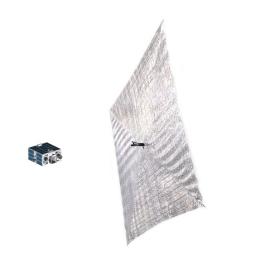
After two days sending data back to Earth, a suspected software glitch in
the LightSail spacecraft's Linux-based flight software has silenced the craft. Every 15 seconds, LightSail transmits a telemetry beacon packet. The software writes corresponding information to a file called beacon.csv. When it reaches 32 megabytes it can crash the flight system. The manufacturer corrected this glitch in later software revisions,
but LightSail's software version doesn't include the update. A fix was scheduled to be uploaded, but before that happened, LightSail fell silent.
A reboot should clear the contents of the problematic beacon.csv file, giving the team a couple days to implement a fix. But the outcome of the freeze is "non-deterministic." Sometimes the processor will still accept a reboot command; other times, it won't. Multiple reboot commands were sent to the spacecraft. Nothing has happened yet. Therefore, we have to assume that LightSail is only going to respond to someone pushing the power button. Spacecraft, however, are susceptible to charged particles zipping through deep space. If one of these particles strikes an electronics component in just the right way, it can cause a reboot. This is not an uncommon occurrence. Cal Poly's experience with CubeSats suggest most experience a reboot in the first three weeks. LightSail is capable of remaining in orbit about six months.
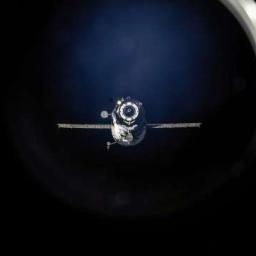
The Russian spacecraft that failed to dock at the International Space Station two weeks ago has safely
crashed back into the Earth. NASA and Russian space agency Roscosmos report that Progress 59, which launched on April 27 on a supply mission to the ISS, re-entered the Earth's atmosphere over the Pacific Ocean at 10:04PM ET last Wednesday night. NASA footage shows the Progress 59 spinning uncontrollably in space after it had launched successfully from Kazakhstan.
The US space agency said, in a statement, that the craft was not carrying any critical supplies and that the Russian and American sides of the ISS were "adequately supplied well beyond the next planned resupply flight." Around a ton of material was expected to have survived the craft's re-entry into the atmosphere, but what was left of the Progress 59 was not a danger to people on the ground as the craft landed somewhere in the central Pacific.
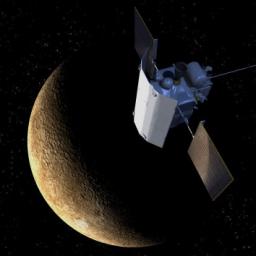
Launched in 2004, NASA's Mercury-orbiting spacecraft, Messenger, is going out with a bang this week, adding a hefty crater to the little planet closest to the sun. The first spacecraft to circle Mercury, Messenger is expected to slip out of orbit and
slam into Mercury on Thursday following a successful four-year tour of the rocky planet. The spacecraft will be traveling 8,750 mph (14,081 kph) when it hits, fast enough to carve out a crater 52 feet (16 meters) wide. The spacecraft itself stretches 10 feet (3 meters) solar wingtip to wingtip. Only one other spacecraft, NASA's Mariner 10, has ever visited Mercury, and that was back in the 1970s. Mariner 10 flew past, but did not orbit the innermost planet.
Messenger has run out of fuel, but ground controllers managed in recent weeks to eke out some extra life, raising Messenger's orbit by dipping into helium gas reserves not originally intended for use as fuel. But now that's all gone and Messenger is at the mercy of gravity. "I guess the end is coming," the Messenger team said via Twitter earlier this week. "After 10 years, spacecraft will end life as just another crater on Mercury's surface." Messenger is expected to crash into the side of Mercury facing away from Earth, so there will be no cameras or observatories to witness the impact. Scientists expect to gather information from Messenger until 10 to 15 minutes before its fatal plunge. The expected crash site is about two-thirds of the way up the planet, near the north pole.
Astronomers are getting ready to do battle with the iRobot corporation over their new lawn mowing robots. The makers of the Roomba are working on a similar device used to mow lawns. Astronomers are
concerned about potential interference with radio telescopes. In February, iRobot filed a waiver request with the FCC to use part of the radio spectrum to guide the robots. The company wants to use the frequency band between 6240 and 6740 MHz, which is a frequency that several large radio telescopes use to observe methanol, which is plentiful in stellar nurseries.
iRobot has proposed adding a note to the user manual: "consumer use only; use must be limited to residential areas." The NRAO doesn't think the approach will work. Liszt and the NRAO say that they need a 55-mile exclusion zone to protect the data obtained by the radio telescopes. It is possible that the radio telescopes could begin generating bad data, without knowing why and without necessarily knowing that the data is bad, if the product goes ahead as planned.
There have been several articles in the recent past about Rutan and his retirement project, a motorglider with the ability to take off and land on rough water, smooth water, snow, and unimproved fields. He has said the range will allow flight from California to Hawaii non-stop at 170 knots.
EAA has some info
here and
here.
Burt said in one article he plans to fly around the world with his wife in the new plane going places where no other plane can go. The design is said to be able to take off and land in just 400 feet allowing for some very out of the way spots to be visited.
This will be a bush plane with a 23 to 1 glide ratio, something unheard of in the aviation world before now.






